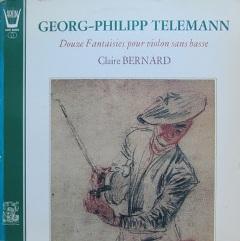Georg Philipp Telemann - 12 Fantasies for Violin Solo (1978)
Georg Philipp Telemann - 12 Fantasies for Violin Solo (1978)

01 Fantasie no.01 in Bes 7:28 02 Fantasie no.02 in G 4:30 03 Fantasie no.03 in f 5:16 04 Fantasie no.04 in D 3:29 05 Fantasie no.05 in A 3:45 06 Fantasie no.06 in e 6:42 07 Fantasie no.07 in Es 5:02 08 Fantasie no.08 in E 3:47 09 Fantasie no.09 in b 4:22 10 Fantasie no.10 in D 4:48 11 Fantasie no.11 in F 3:42 12 Fantasie no.12 in a 4:47 Claire Bernard, violin (Guarneri)
The fantasia form seems to be one that Telemann liked to explore, and the notes of the CD tells us that besides this dozen for the solo violin, he also wrote twelve for the flute and the viola da gamba, plus three dozen for the harpsichord. The fantasia consists of three- to four-part themes which ranges from largo to presto, which unite together subtly to form a whole.
Georg Philipp Telemann Polyphony in the Twelve Fantasias for Solo Violin without Bass (XII Fantasias per il Violino senza Basso) is not as developed as Bach's famed Sonatas and Partitas for the solo violin, but instead there is a conversation between the bass and melody line, using the different strings of the violin to create different voices. This effect can be recognised right from the first Fantasia, where the G and E string of the violin is used alternately to answer each other in the movement, in contrast to the outright counterpoint use of chords in the fugues of Bach's solo violin music.
The fast movements always have a touch of spirituoso in them, sustaining exciting momentum by further developing the main idea before a recapitulation of the original theme, as in the Allegro of the Seventh Fantasia. Then, there are slow movements that are juxtaposed between the more lively ones. Sometimes, these are just a short phrase played softly in andante pace that comes after the allegro, like the line of silent monologue of the violin after the exposition of the Fifth Fantasia. In others, they are adagio parts having a prominent place in the piece.
The Eleventh Fantasia is an example of the development being led by a gentle and graceful theme, which makes up half of the whole fantasia and is further more repeated immediately after a change in motif. Unlike Bach's music, there is no extensive use of doublestops for counterpoint melodies, and the music is quite simple technically speaking, with almost all the twelve Fantasias playable on the violin without a shift of position from the first.
Admittably, the Fantasias are not pieces with intrinsic value for the violin virtuoso, nor are they anywhere near the greatness of the Sonatas and Partitas for the solo violin by Bach. But in my opinion that does not mean that they lack musical value. They are baroque violin music of a different sort altogether, and Telemann's contribution to the violin repertoire with these seems to be a development of the Vivaldi style with their similarities. Where Bach seems to be exploring the possibilities of the counterpoint on the violin by looking from the perspective of an organ player, Telemann is more concerned with musical ideas that are more organic in nature. --- inkpot.com
download (mp3 @320 kbs):
uploaded yandex 4shared mediafire mega solidfiles cloudmailru filecloudio oboom
Zmieniony (Poniedziałek, 03 Listopad 2014 16:51)








